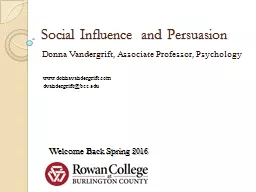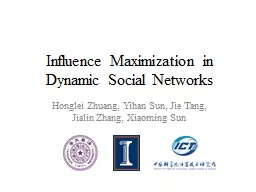PPT-Social Influence and Persuasion
Author : pamella-moone | Published Date : 2016-11-14
Donna Vandergrift Associate Professor Psychology Welcome Back Spring 2016 wwwdonnavandergriftcom dvandergriftbccedu Social Influence and Persuasion Convincing others
Presentation Embed Code
Download Presentation
Download Presentation The PPT/PDF document "Social Influence and Persuasion" is the property of its rightful owner. Permission is granted to download and print the materials on this website for personal, non-commercial use only, and to display it on your personal computer provided you do not modify the materials and that you retain all copyright notices contained in the materials. By downloading content from our website, you accept the terms of this agreement.
Social Influence and Persuasion: Transcript
Download Rules Of Document
"Social Influence and Persuasion"The content belongs to its owner. You may download and print it for personal use, without modification, and keep all copyright notices. By downloading, you agree to these terms.
Related Documents














